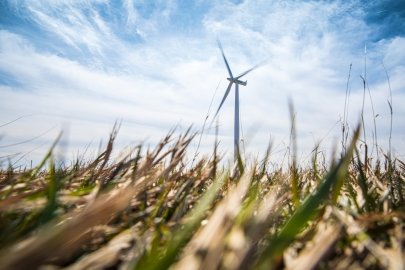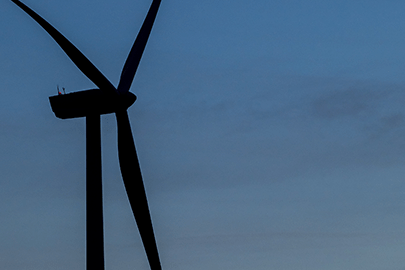The American WAKE experimeNt—a massive data collection effort funded by WETO—could help U.S. wind farms produce more energy, increase profits, and, eventually, reduce electricity prices for consumers.
Wind Energy Technologies Office
May 16, 2022New Dataset Could Help Wind Plants Produce More Energy for the Same Price
Drought conditions in Oklahoma are getting worse. Even minor drought can stress crops, delay germination, and shrink water supplies. Oklahoma might not have enough water, but it has plenty of wind, and its wind farms are booming.
Now, a massive data collection effort funded by the U.S. Department of Energy’s (DOE’s) Wind Energy Technologies Office could help wind farms across Oklahoma—and the world—increase their energy production with a few strategic moves. Launched in March 2022, the American WAKE experimeNt (or AWAKEN, for short) captures precise data on how winds shift as they travel from one wind turbine to another or from one wind plant to another. This atmospheric map could help developers adapt their wind plant designs to produce more energy from the same winds, increase profits, and, eventually, reduce electricity prices for consumers.
“The AWAKEN project will amass the world’s most comprehensive dataset on wakes and other atmospheric phenomena,” said Patrick Moriarty, a senior engineer at the National Renewable Energy Laboratory (NREL) who is leading the project. “With this dataset, the wind industry can select the most effective technologies, sites, and wind plant designs to maximize their energy production and provide affordable, clean energy to communities around the world.”
Current wind energy models are too imprecise to calculate exactly how much energy is lost to mysterious atmospheric manipulations such as wakes. Like water ripples that form behind boats, wakes occur as winds flow past wind turbines. This interaction can cause turbulence and reduce the amount of energy that reaches the next wind turbine or even a wind plant up to 20 miles away. While wakes could be costing wind plants about 10% of their potential energy, more data are needed to determine how much of that energy wind plants lose and, more importantly, how that loss can be avoided.
The AWAKEN team—a collaboration with DOE’s Wind Energy Technologies Office and Atmospheric Radiation Measurement user facility, as well as NREL, Sandia National Laboratories, Pacific Northwest National Laboratory, and Lawrence Livermore National Laboratory—plans to fill that data gap.

Strange things can happen when winds flow past wind turbines. And these phenomena, which can influence how much energy a wind plant can produce, have not been well understood. Now, a new data collection effort is changing that.
Between 2022 and 2023, Moriarty and his team of DOE-funded researchers will use sensors, including radar, lasers, and aircraft, to track atmospheric phenomena in five different wind plants in northern Oklahoma (chosen for the state’s robust wind resources and great promise as a wind energy producer). Those sensors will provide a precise three-dimensional wind map that the NREL researchers can use to validate and upgrade existing wind energy models. Cross-checking existing simulation tools with the new observational data will enable the researchers to develop highly accurate models for future developers to consult when building their wind farms.
But that’s not all. The AWAKEN team will also gather data on wind plant control strategies—for example, how to turn individual turbines to face the wind (known as yawing) to optimize their energy production.
Want to follow AWAKEN’s progress? Visit the project website to learn more.
“Validating wind plant control strategies will lead to improved wind farm layout with greater power production and improved reliability, ultimately leading to lower wind energy costs,” said Moriarty.
To design AWAKEN’s measurement campaign, the team traveled to Oklahoma in summer 2021 to scope out ideal locations—those without trees, buildings, or hills obstructing their view—to place their data-gathering sensors. For the final step, the team will use aircraft outfitted with even faster sensors that can gather more precise data and track how wakes from one wind plant might affect another 20 miles downwind.
By 2023, with the data collection complete, Moriarty and his team will create an open-source, globally accessible dataset hosted in the DOE’s Wind Data Archive and Portal.
Worldwide, the price of electricity from wind continues to drop. By providing data on where and how to build wind plants to optimize energy production, the AWAKEN project could help make electricity from wind energy even more affordable. The AWAKEN project is part of DOE’s Atmosphere to Electrons initiative, which aims to significantly reduce the cost of wind energy through an improved understanding of the complex physics governing how wind plants generate electricity.
“It’s a win-win,” said Moriarty. “Wind farms produce more energy. Consumers pay less for their electricity. Many stand to benefit from the AWAKEN dataset.”
For more information, download the AWAKEN fact sheet.
Subscribe to the WETO e-newsletter to stay informed on the latest wind energy news, events, publications, and updates.








